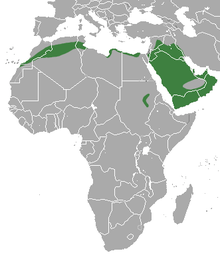Desert hedgehog
| Desert hedgehog | |
|---|---|
 | |
| Scientific classification | |
| Kingdom: | Animalia |
| Phylum: | Chordata |
| Class: | Mammalia |
| Order: | Eulipotyphla |
| Family: | Erinaceidae |
| Genus: | Paraechinus |
| Species: | P. aethiopicus |
| Binomial name | |
| Paraechinus aethiopicus (Ehrenberg, 1832) | |
 | |
| Desert hedgehog range | |
The desert hedgehog (Paraechinus aethiopicus) is a species of mammal in the family Erinaceidae.
Description
The desert hedgehog is one of the smallest of hedgehogs. It is 5.5 to 11 inches (140 to 280 mm) long and weighs about 10 to 18 ounces (280 to 510 g). The spines on its back can be banded with coloring similar to the four-toed hedgehog.It is usually identified by its dark muzzle. If desert hedgehogs are threatened, their muscles go tight and pull the outer layer of skin around the body, making their spikes stick out in all directions. The spines tend to be longer than other hedgehogs for better protection against predation. As such it almost impossible to catch one.
Habitat
It is found in the Sahara Desert, Algeria, Chad, Djibouti, Egypt, Eritrea, Iran, Iraq, Israel, Jordan, Kuwait, Libya, Mali, Mauritania, Morocco, Niger, Oman, Saudi Arabia, Somalia, Sudan, Syria, Tunisia, United Arab Emirates, Yemen, and possibly Ethiopia.
Breeding
Breeding begins in March, after hibernation has ended. The female desert hedgehog gives birth to up to six young, in a burrow or concealed nest, after a gestation period of around 30 to 40 days. The young are born deaf and blind, and with the spines located just under the skin, to prevent damage to the female during birth. The spines emerge within a few hours, and the eyes open after around 21 days. The young desert hedgehogs are weaned after about 40 days. There is thought to be single litter each year.
Threats
The desert hedgehog is reported to be a common species with a wide distribution and a large population. It is believed to be reasonably tolerant of habitat modification, and is not considered globally threatened. No major threats are reported for the species, although some note that increasing desertification within its range may be leading to the fragmentation of its populations, and in some areas it may suffer increased mortality due to road traffic.
External links
![]() Media related to Paraechinus aethiopicus at Wikimedia Commons
Media related to Paraechinus aethiopicus at Wikimedia Commons
